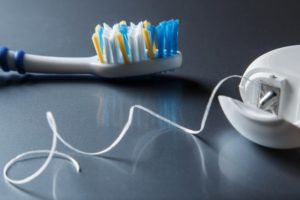
Did you know that some dental experts report that brushing your teeth only removes about 60% of plaque and bacteria from your mouth? The remaining 40% hides where toothbrush bristles can’t reach, like between your teeth and just underneath the gumline, which is why flossing is so important for a healthy smile! However, if you want to make the most of your dental routine, should you floss before or after brushing your teeth? The answer may surprise you! Read on as your Jonesboro dentist explains the pros and cons of each.
Flossing After Toothbrushing Optimizes Fluoride Coverage
To understand why you might want to floss after brushing your teeth, it’s important to understand how fluoride works. This important mineral is found in most toothpastes and tap water systems. Once it’s mixed with your saliva, the protective shell of enamel around your teeth can absorb it. By combining with other compounds there it creates fluoroapatite, which is resistant to decay and strengthens the enamel against cavities.
Some dentists believe that flossing is most effective after more fluoride has been introduced into your mouth with toothbrushing. Theoretically, flossing under this condition helps to maneuver the fluoride into those small spaces your toothbrush can’t reach, therefore maximizing its coverage.
Flossing Before Toothbrushing Reduces Plaque Buildup
However, research from the American Academy of Periodontology indicates that fluoride may work better when used after flossing. In their study, participants who flossed before brushing had less plaque overall and retained more fluoride than those who flossed after brushing. This led them to the conclusion that removing bacteria and debris before applying fluoride boosted its performance.
When beginning a dental routine with flossing, plaque and bacteria are removed from those tough-to-clean spaces like between the teeth and just under the gumline. By reducing this buildup, the fluoride is able to reach the enamel unhindered and penetrate it more easily. Additionally, dental experts believe that introducing the fluoride at the end of a dental routine allows it to stay in contact with the teeth for a longer period of time instead of being scraped off by flossing afterwards.
The Bottom Line
As the research stands, it appears that flossing your teeth before brushing them may be the more effective option. However, regardless of when you floss, the most important factor is that you floss regularly. Allowing the plaque and bacteria leftover after brushing to build up may lead to an increase in tooth decay and a bacterial infection in your gum tissue, which is known as gum disease. Thankfully, with daily great oral hygiene practices and biannual checkups with your dentist, you can easily keep your smile happy and healthy.
About the Author
At Woodsprings Family Dentistry in Jonesboro, AR, we are focused on creating confident, beautiful smiles by finding solutions that work for you and your lifestyle. With over seven years’ experience in dentistry, countless hours of continuing education, and the latest advanced dental technology, Dr. Sarah Yarnell will make sure that you’re as relaxed and comfortable as possible while you get the excellent oral healthcare you deserve. She’d be happy to go over more ways to make your dental routine more effective during your regular dental checkup, via her website, or at (870) 932-8488.
